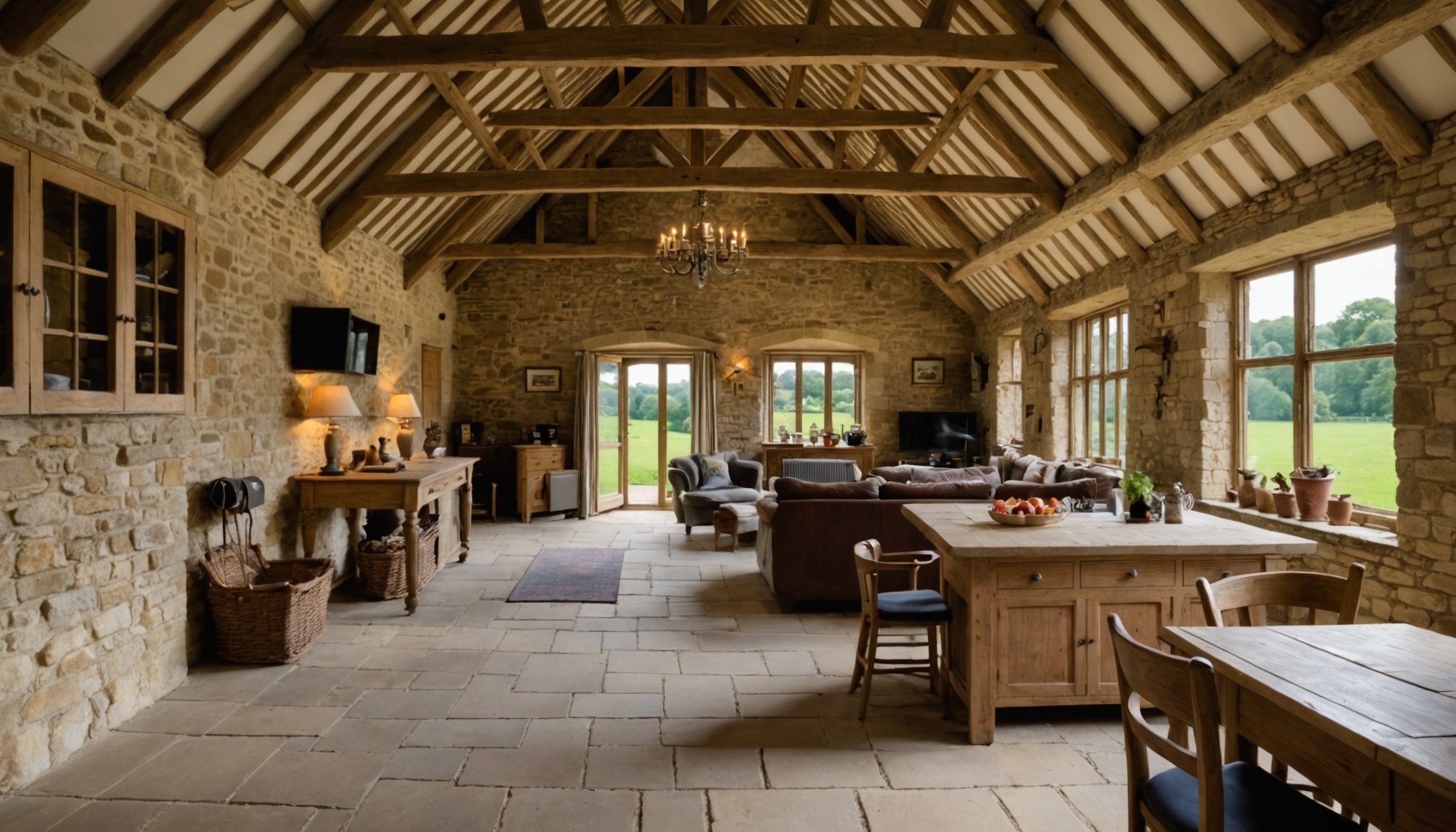Economic Benefits of Transforming Cotswold Barns
Transforming Cotswold barns into holiday retreats can significantly bolster the economic impact on the local community. A notable increase in local tourism has been observed as these picturesque venues attract visitors seeking unique stays. As footfall in the area rises, local businesses—from cafes to artisan shops—enjoy increased patronage, thereby enhancing the region’s overall tourism revenue.
The transformation of barns also results in a remarkable surge in property values. As barn conversions become increasingly desirable, property investors and developers are drawn to the area, boosting the Cotswolds’ appeal as a premier holiday destination. This appreciation not only increases the monetary value of these properties but also elevates the area’s status in real estate markets.
In parallel : Maximizing Investment Opportunities: Capitalizing on London’s Surging Demand for Co-Working Spaces
When comparing revenue generated from holiday retreats to traditional uses of barns, the economic advantages are clear. Converted barns typically yield higher income, attracting families and tourists willing to pay for the unique experience. In contrast, traditional uses, such as agriculture or storage, generate comparatively lower revenue. This economic shift favors barn conversions, suggesting a trend towards more profitable and sustainable tourism-focused developments.
Investment Returns and Financial Considerations
Navigating through investment analysis for barn conversions requires attention to both initial investments and ongoing costs. Transforming a barn into a liveable space typically demands a sizable conversion cost, which can vary depending on the project’s complexity. Essential considerations include structural integrity assessments and fitting out modern amenities, which all add to the total investment.
Also to read : Charming ski apartments for sale in méribel await you!
Once the barn conversion is complete, profitability largely depends on the average ROI in the holiday rental sector. In rural areas, properties frequently benefit from higher ROI due to the growing demand for unique, serene vacation spots. However, accurately predicting returns involves evaluating location attractiveness, potential rental income, and seasonal occupancy rates.
A strategic exploration of financial incentives and grants can alleviate some financial burdens associated with property renovations. Various schemes are available to support sustainable infrastructure improvements, energy-efficient installations, and historical preservation. Engaging with these financial supports means deeply understanding eligibility requirements and application processes.
For investors, these elements represent a comprehensive approach towards refining their financial strategy. Ensuring detailed planning parallels making informed decisions about potential returns and managing conversion expenses, integrating both short-term and long-term financial goals fluidly.
Socio-Economic Impacts on Local Communities
The influence of tourism on community development is vast, particularly through the creation of employment opportunities. New roles in hospitality and maintenance are key in providing jobs, helping to bolster the local economy. Such growth not only minimizes unemployment but also fosters skills development among residents.
Local businesses also reap significant benefits from increased visitor traffic. Restaurants, shops, and services experience heightened demand, often leading to expansion or the opening of new ventures. This influx can transform a once-quiet town into a bustling hub of activity. However, this transformation must be managed carefully to ensure it aligns with community needs and interests.
Balancing development with these local needs is crucial. While economic growth is beneficial, it should not overshadow the cultural and social fabric of the areas affected. Community involvement in planning and decision-making helps preserve essential characteristics while reaping economic benefits.
Ultimately, sustainable development that involves local businesses helps maintain the character of the community, supports employment, and drives prosperity. When communities are proactive in shaping their development, they create environments that benefit both residents and visitors, ensuring long-term success and vibrancy.
Environmental Considerations in Barn Conversions
When tackling barn conversions, sustainability plays a crucial role in ensuring that these unique structures are transformed responsibly. One of the foremost considerations is preserving the historical and architectural integrity of the building. This involves using eco-friendly practices during renovations, such as sourcing materials that match the original aesthetic while being environmentally sound.
Adhering to sustainable practices in construction extends beyond material choice to include energy efficiency improvements. This could involve installing high-grade insulation or energy-efficient windows which help minimize energy consumption, making holiday retreats less impactful on the environment. Incorporating renewable energy sources, such as solar panels, is another example of fostering sustainability.
Before commencing any conversion project, it’s imperative to conduct an environmental impact assessment. These assessments are guided by regulations that aim to mitigate adverse effects on the local ecosystem. Understanding conservation requirements is key to not only meeting legal standards but also to ensuring that the resulting conversion harmonizes with its surroundings.
In conclusion, employing these eco-friendly and sustainable strategies not only benefits the environment but also enhances the appeal and authenticity of barn conversions for holiday retreats.
Case Studies of Successful Barn Transformations
Transforming barns into viable properties has become a thriving practice in the Cotswolds, marked by numerous success stories. Let’s delve into some notable examples of these transformations, and uncover the key factors behind their success.
One remarkable case study analysis involves a 19th-century barn in a Cotswold village that was converted into an eco-friendly family home. This project gained community acceptance due to its emphasis on sustainability and preservation of historical aspects. The developers used reclaimed materials, which not only minimized the environmental impact but also maintained the barn’s original charm.
Another success story features a large barn, transformed into a community arts centre. The project demonstrated commendable best practices by involving local artists and artisans from the start. Their participation not only enriched the project with creativity but also fostered a sense of ownership and pride within the community.
From these examples, a few lessons emerge that could guide future projects:
- Respect for local culture boosts community acceptance.
- Incorporating sustainable practices can enhance appeal and functionality.
- Involving the community early can lead to projects that are both innovative and rooted in local identity.
These insights underscore the potential for barn conversions, offering practical guidelines for those embarking on similar ventures.
Strategies for Effective Conversion Processes
Transforming a barn into a captivating holiday retreat involves strategic planning and thoughtful execution. The process begins with meticulous project management, crucial for navigating each phase effectively. Start by identifying the essential steps, from securing permits to finalising designs. Engaging with local stakeholders and authorities at every stage ensures smoother compliance and adaptation to local regulations. This includes understanding zoning laws, building codes, and environmental impact assessments. By addressing these early, you minimise potential delays.
Design considerations play a pivotal role in enhancing the appeal of converted holiday retreats. Thoughtfully incorporate features that highlight the structure’s rustic charm while providing modern comforts. Consider aspects like lighting, insulation, and space optimisation to create a balance between traditional aesthetics and contemporary functionality. Include open floor plans and large windows to enhance spaciousness and invite natural light.
Stakeholder engagement remains crucial throughout the project. Regular consultations with architects, building contractors, and interior designers create a harmonious vision. Encourage input from potential customers to ensure the design aligns with market expectations. By integrating project management skills, design insights, and stakeholder collaboration, your barn conversion can achieve both functionality and aesthetic appeal, attracting guests seeking unique holiday experiences.
Regulatory Aspects and Planning Permissions
Converting agricultural buildings involves a myriad of legal requirements and nuances. Firstly, understanding local zoning laws is crucial. These laws dictate whether agricultural land can be reclassified for residential or commercial use. Often, developers face hurdles in aligning projects with stringent zoning regulations designed to preserve farming land.
Planning permissions play an essential role in this transformation. Such permissions ensure that any proposed development complies with the intended land use and community standards. The complexity arises as these permissions can vary significantly, not just from region to region, but also based on the specific nature of the development project. Developers may encounter bureaucratic challenges or red tape, which requires meticulous preparation and compliance.
To alleviate these challenges, several resources are available for project developers. Local councils often provide guidelines and consultation services to aid in understanding planning permissions and navigating the administrative process. Additionally, hiring a legal consultant with expertise in zoning laws can be invaluable. These professionals can offer insights and strategies to streamline compliance, making the journey from agricultural to functional building smoother and more efficient.











